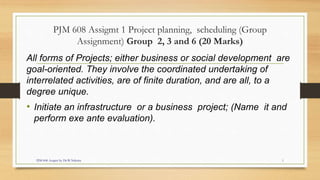
PJM 608 Revised Group work Assignment .pptx
- 1. PJM 608 Assigmt 1 Project planning, scheduling (Group Assignment) Group 2, 3 and 6 (20 Marks) All forms of Projects; either business or social development are goal-oriented. They involve the coordinated undertaking of interrelated activities, are of finite duration, and are all, to a degree unique. • Initiate an infrastructure or a business project; (Name it and perform exe ante evaluation). PJM 608 Assgmt by Dr.W.Nderitu 1
- 2. Cont’ Be practical and creative • Plan and schedule it right from conceptualization to commissioning. N.B; for a business project; operationalize a business plan. • critical maximization of profits is a key outcome; see a scheduling sample nxt slide • Consider todays emerging issues like shocks i.e Covid -19 implications in your schedules. How do you caution your infrastructure project from such shocks? PJM 608 Assgmt by Dr.W.Nderitu 2
- 3. PJM 608 Assgmt by Dr.W.Nderitu 3
- 4. Group work on Project maturity Group 1,4,5 (20 Marks) Real Case study • In the growing world of Projects; study the following case study keenly and • Perform project maturity analysis. • Critically analyze all forms of maturity and sustainability of the project
- 5. Starehe Boys High school-Kenya case-study • Early in 1959, a young civil servant, Dr. Geoffrey Griffin, was attempting to raise funds for a private venture to help boys who were homeless or needy and to draw public attention to the enormous social problem existing among juveniles. Backed by the Shell/BP Oil Companies and the Sheikh Trust, he set out to establish a small residential centre in the crowded and depressed eastern locations of Nairobi City then.
- 6. Cont’ • The Save the Children Fund of Britain became Starehe's largest overseas supporter and was instrumental in interesting its counterparts in other countries. Starting with the Dulverton Trust and Oxfam, various trusts, foundations, charitable bodies and the technical assistance, volunteer agencies helped to build up the teaching staff, and a growing number of private individuals, schools and societies contributed to the running costs of the Centre by 'sponsoring' particular boys
- 7. Cont’ • As time went on, the Centre became national by opening its doors to the rural, as well as the urban, poor. It was realized that disadvantaged boys should not be raised in isolation from the rest of the society, but should live and learn, work and play with the sons of normal families, so it was decided that fee-paying pupils could occupy one third of the places while the other two thirds remain free and are strictly reserved for the poor and helpless.
- 8. Cont’ • The founder set out, not merely to provide food, clothing and protection to boys in need, but to restore in them the self-confidence and self-respect so often injured by earlier misfortunes in lives, and finally, to provide them with sound enough-to serve them well in today's competitive world. • Many prominent Kenyans came to take a personal in starehe and the Ministry of Education gave and continued to give increasing encouragement and to date.
- 9. Practical Question: (20 marks) Study the case study keenly. • In reference to the Starehe Boys high school in Kenya; • Critically analyze all forms of project maturity and sustainability that you can deduce from the project. • How can this project be replicated in developing countries today; in aspect of globalization and emerging shocks like Covid-19 implications?